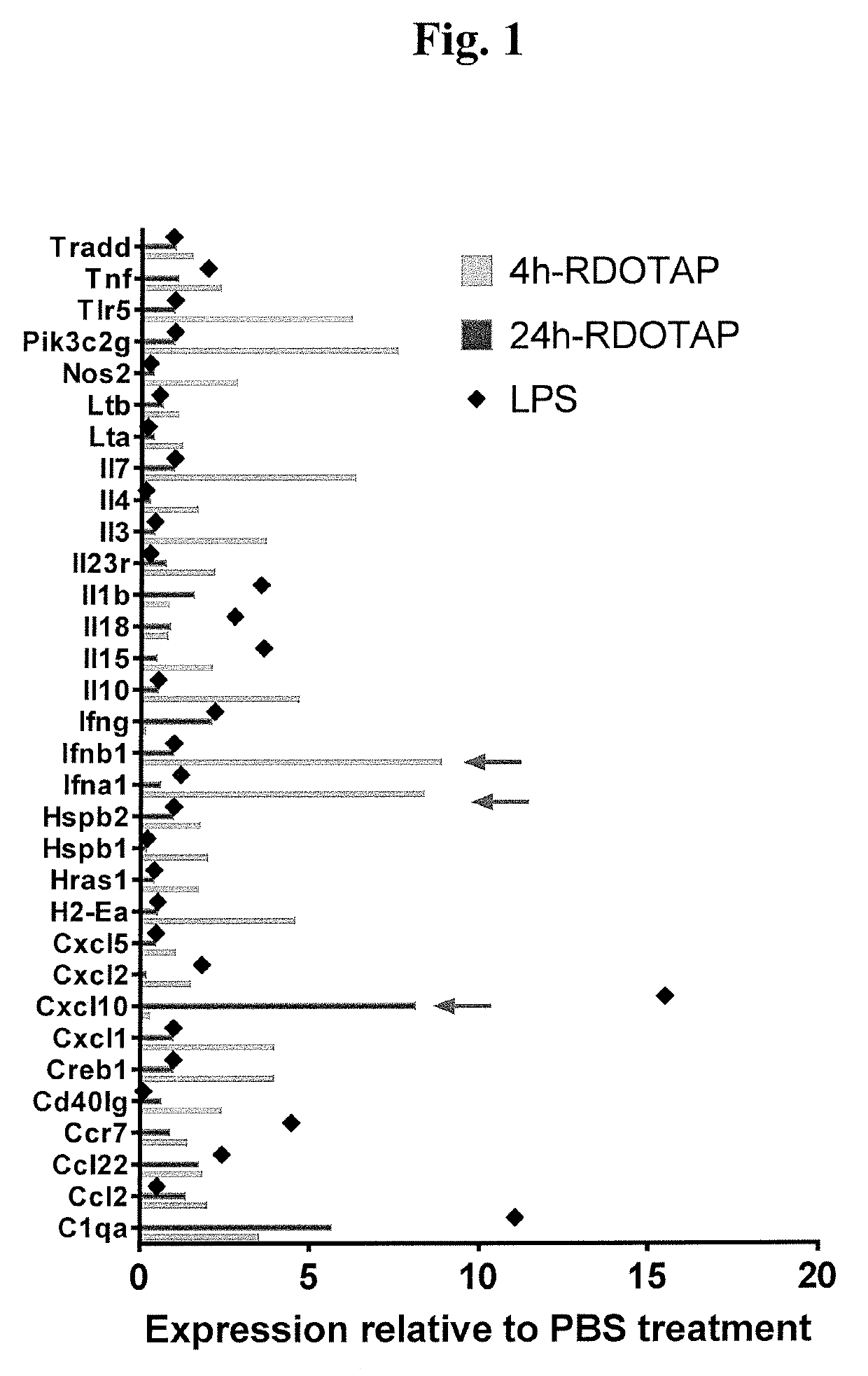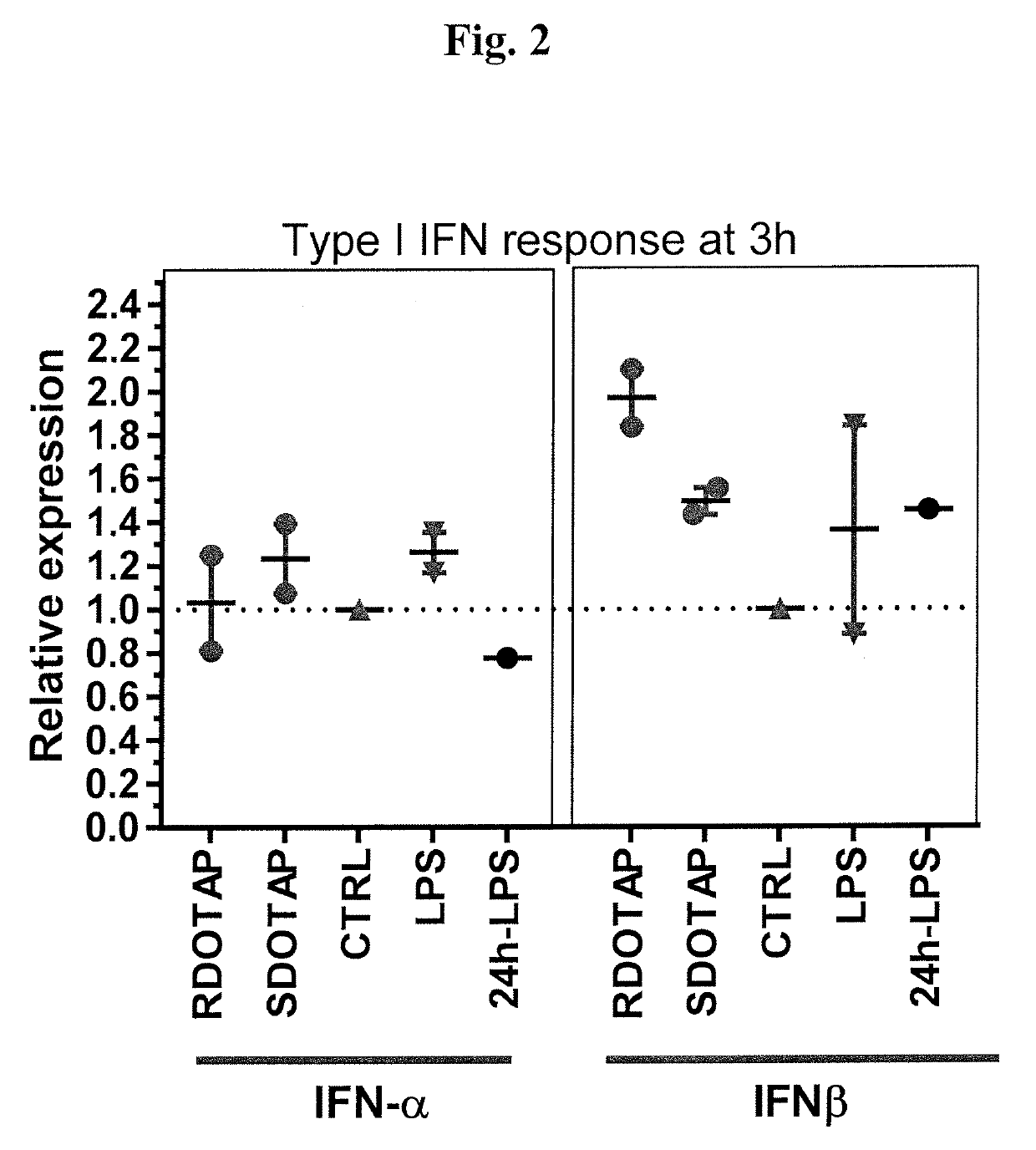Methods and compositions comprising cationic lipids for stimulating type 1 interferon genes
a technology of cationic lipids and interferon genes, which is applied in the direction of antibody medical ingredients, dsdna viruses, immunological disorders, etc., can solve the problems of failure to establish long-lasting protective or therapeutic benefits, and achieve the effect of effective prevention and robust cytotoxic t cell immune respons
- Summary
- Abstract
- Description
- Claims
- Application Information
AI Technical Summary
Benefits of technology
Problems solved by technology
Method used
Image
Examples
example 1
R-DOTAP Induces Type I Interferon Gene Expression in Draining Lymph Nodes
[0095]To assess cationic nanoparticle induced gene expression, C57BL / 6J mice were injected with 100 μl of 12 mM R-DOTAP nanoparticles subcutaneously behind the neck, and inflammatory gene expression in draining lymph nodes analyzed 4 or 24 hours post vaccination. Mice injected with PBS, and LPS (50 μg / mouse) (24 h time point) were used as negative and positive controls respectively. 4 h or 24 hr after injection, axillary and brachial draining lymph nodes from each mouse were pooled and processed by collagenase digestion. Activated dendritic cells (CD11c+) cells in the lymph node cell suspensions were sort-purified and lysed in RLT buffer and processed for relative gene expression analysis using nCounter® mouse inflammation kit and nanostring technologies. R-DOTAP injection was found to significantly alter the expression of several inflammatory genes at both time points. Several genes including IFN-1a and IFN-1β...
example 2
R-DOTAP and S-DOTAP Both Induce Interferon-α and Interferon-β Gene Expression in Draining Lymph Nodes
[0096]To compare type I Interferon gene expression by both R- and S-DOTAP, a similar study as outlined in Example 1 was performed. C57BL / 6J mice were injected with 50 μl of 6 mM RDOTAP nanoparticles subcutaneously in the foot pads. Mice injected with PBS, and LPS (50 μg / mouse) (24 h time point) were used as negative and positive controls respectively. 3 h or 24 hr after injection, popliteal draining lymph nodes from each mouse were pooled and lysed in RLT buffer and processed for relative gene expression analysis using Taqman® gene expression assay and RT-PCR. The studies confirm that both R- and S-DOTAP are strong inducers of the type I interferons (FIG. 2).
example 3
R-DOTAP and S-DOTAP Upregulate Type I Interferon-Associated CD69 Expression on T-cells
[0097]To further understand the effect and ability of cationic lipids to activate the type I interferons, C57BL / 6J mice or IFNAR− / − mice were injected with 50 μl of 6 mM R-DOTAP nanoparticles or 6 mM S-DOTAP or 280 mM sucrose subcutaneously in the foot pads. 24 hr after injection, popliteal draining lymph nodes from each mouse were isolated and single cell suspensions of lymph nodes were stained with fluorochrome conjugated CD3 and CD69. R-DOTAP alone (without antigen) resulted in a visible increase in DLN size and this was due to a steady increase in total cell number over a 7-day period (FIG. 3A). Studies of T-Cell influx into the DLN with pertussis toxin suggest that lipids structurally related to R-DOTAP induce lymph node homing chemokines, most likely a direct result of type I IFN signaling. This increase in total cell number was confirmed to be dependent on type I IFN signaling as it was grea...
PUM
| Property | Measurement | Unit |
|---|---|---|
| Immunogenicity | aaaaa | aaaaa |
Abstract
Description
Claims
Application Information
 Login to View More
Login to View More - R&D
- Intellectual Property
- Life Sciences
- Materials
- Tech Scout
- Unparalleled Data Quality
- Higher Quality Content
- 60% Fewer Hallucinations
Browse by: Latest US Patents, China's latest patents, Technical Efficacy Thesaurus, Application Domain, Technology Topic, Popular Technical Reports.
© 2025 PatSnap. All rights reserved.Legal|Privacy policy|Modern Slavery Act Transparency Statement|Sitemap|About US| Contact US: help@patsnap.com



